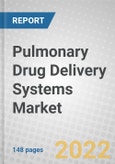This report will provide a detailed look at the pulmonary drug delivery systems market, highlighting major pulmonary diseases with detailed epidemiology for major disease areas such as asthma, COPD and cystic fibrosis. The report includes an industry-wide assessment of the novel products, launches, recent approvals, R&D pipeline and blockbuster drugs.
In the report, the regulatory scenario of pulmonary drug delivery systems is discussed for each device type. This will include products approved by regulatory authorities in recent years. Products under development or in different stages of clinical trials are also analyzed.
The report includes profiles of major companies in the market for pulmonary drug delivery systems, with overviews of their key product offerings and financials.
Report Includes
- 44 tables
- A brief overview and up-to-date analysis of the global markets for pulmonary drug delivery systems
- Analyses of the global market trends, with historic market revenue data from 2019 to 2021, estimates for 2022, and projections of compound annual growth rates (CAGRs) through 2027
- Estimation of the actual market size and revenue forecast for pulmonary drug delivery systems in USD value terms, and their corresponding market share analysis by type of drug delivery systems, application/disease area and region
- Highlights of the major pulmonary diseases with detailed epidemiology for major disease areas such as asthma, COPD and cystic fibrosis; also, an industry-wide assessment of the key developments, novel products, recent approvals, R&D activities, pipeline products and blockbuster drugs
- In-depth information (facts and figures) concerning market drivers, opportunities and challenges, and other macroeconomic forces affecting the global pulmonary drug delivery systems market
- Holistic review of the international regulatory landscape for pulmonary drug delivery systems with emphasis on recently approved products as well as products under development or in different stages of clinical trials
- Updated information on key mergers and acquisition deals, agreements, collaborations and other impactful strategies adopted by key players in the global pulmonary drug delivery systems market
- Assessment of the recent patents published and granted on pulmonary drug delivery systems and related technologies
- Identification of the major stakeholders and analysis of the competitive landscape based on recent developments and segmental revenues
- Descriptive company profiles of the market leading players, including Abbott, Dr. Reddy’s Laboratories Ltd., GlaxoSmithKline PLC, Lupin and Pfizer Inc.
Table of Contents
Executive Summary
Pulmonary drug delivery is an alternative to oral drug delivery. Pulmonary drug delivery is primarily advantageous for the treatment of respiratory diseases because it involves systemic administration via the alveolar region, which leads to fast absorption. The pulmonary drug delivery method depends on the development of simple, cost-effective and easy-to-use devices. These devices are designed to facilitate consistent drug delivery with increased lung penetration and multi-dosage facilities. Currently, manufacturers are concentrating on the development of small, portable devices that encourage higher patient compliance.
Chronic obstructive pulmonary disease (COPD) is the third leading cause of death worldwide according to the World Health Organization (WHO). In low and middle-income nations, COPD deaths in individuals under 70 years of age account for nearly 90% of all deaths in low- to middle-income countries (LMICs). To stop the progression of symptoms and lessen flare-ups, early diagnosis and treatment are necessary, including support for quitting smoking. Key COPD risk factors include occupational exposure to dust, fumes and chemicals; indoor air pollution; and tobacco smoke. Long-term exposure to toxic gases and particles combined with individual factors, such as childhood lung development-influencing events and genetics, cause COPD. COPD results in persistent and advancing respiratory symptoms, such as coughing up phlegm and having trouble breathing.
The market for pulmonary drug delivery systems is growing rapidly due to the rising prevalence of respiratory disorders such as asthma, COPD and other chronic illnesses. Other factors driving its growth are the emergence of novel inhaler designs and increased use of noninvasive drug delivery methods.
Companies Mentioned
- 3M
- Abbott Laboratories
- Astrazeneca
- Boehringer Ingelheim GmbH
- Cipla
- Dr. Reddy's Laboratories Ltd.
- GlaxoSmithKline plc
- Philips Respironics
- Lupin
- Mylan N.V.
- Merck Kgaa
- Novartis AG
- Omron Corp.
- Pfizer Inc.
- Pulmatrix Inc.
- Teva Pharmaceuticals Industries Ltd.
Table Information
| Report Attribute | Details |
|---|---|
| No. of Pages | 148 |
| Published | November 2022 |
| Forecast Period | 2022 - 2027 |
| Estimated Market Value ( USD | $ 57.4 Billion |
| Forecasted Market Value ( USD | $ 76.9 Billion |
| Compound Annual Growth Rate | 6.0% |
| Regions Covered | Global |
| No. of Companies Mentioned | 16 |









